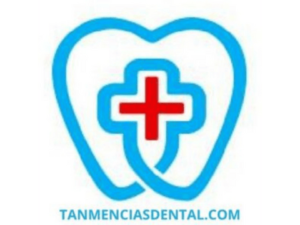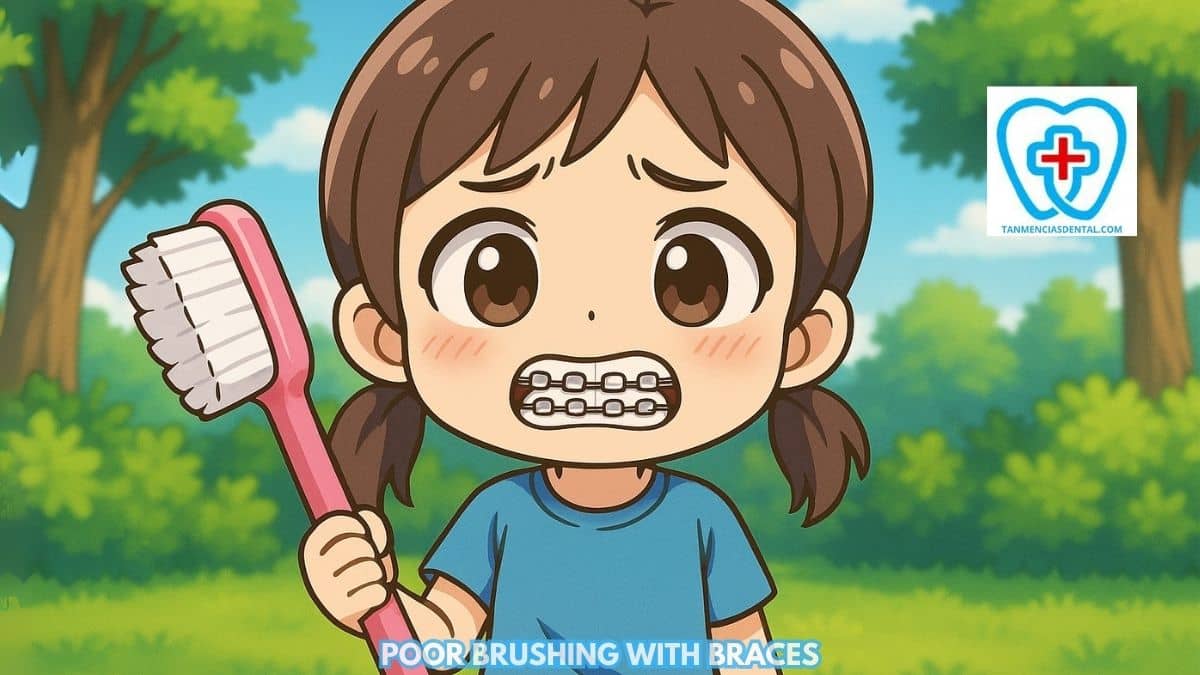Braces are designed to straighten teeth, but they also make cleaning more challenging.
Food can easily get stuck in the wires and brackets, which attracts harmful bacteria.
When brushing is not done carefully, these bacteria cause serious damage to both teeth and gums.
The small gaps created by braces become areas where plaque can grow quickly.
Learning how poor brushing with braces harms oral health is important for preventing lasting problems.
1. Plaque Buildup Around Brackets
Brackets and wires create tight areas where plaque easily collects.
Plaque is a sticky film made of bacteria, food, and saliva that sticks to the teeth.
If brushing is incomplete, the plaque around the brackets hardens into tartar, which is much harder to remove.
This buildup weakens the surface of the teeth and irritates the gums.
Over time, constant plaque exposure makes teeth more likely to develop permanent damage.
🦷 Should You Use Coconut Oil for Brushing Your Teeth?
2. Enamel Decalcification And White Spots
Decalcification happens when acids in plaque remove minerals from the enamel.
These spots often appear as cloudy white marks on the front of teeth.
Once they form, they cannot be brushed away and may stay even after braces are removed.
Poor brushing with braces makes decalcification more common because acids remain longer on the tooth surface.
Protecting enamel during treatment requires consistent and thorough cleaning.
🦷 Why You Need an Orthodontic Toothbrush During Braces Treatment
3. Increased Risk Of Tooth Cavities
When plaque is not removed, bacteria use sugars from food to produce acids that weaken the enamel.
Gradually, these acids create small holes in the teeth, known as cavities.
People with braces are at greater risk because food often gets stuck around brackets and wires, giving bacteria more fuel to grow.
Cavities during orthodontic treatment can cause pain and may require extra dental work, which can interrupt progress.
Using fluoride toothpaste and rinsing with mouthwash can help strengthen enamel and reduce harmful bacteria.
Good daily care lowers the chances of cavities and keeps teeth healthier during treatment.
🦷 Top Foods to Help with Gingivitis and Improve Gum Health
4. Gum Inflammation And Gingivitis
Food particles and bacteria near the gums cause redness and swelling.
Brushing poorly with braces allows these irritants to sit close to the gumline.
As the days pass, the gums become tender, bleed easily, and show signs of gingivitis.
If this early stage of gum disease is ignored, it can worsen into more serious conditions.
Regular cleaning around the braces is essential to keep the gums healthy.
🦷 Should You Rinse Your Mouth After Brushing?
5. Periodontal Disease Risk
When gingivitis is not treated, it can develop into periodontal disease.
This condition affects the deeper tissues that support the teeth and can cause serious harm if ignored.
The infection spreads below the gum line and may begin to damage the bone and fibers that hold teeth firmly in place.
Poor oral hygiene makes this process more likely because plaque and bacteria remain for longer periods.
As time goes on, the gums may recede, and teeth can become loose.
If the disease is not controlled, permanent tooth loss can occur.
Good daily care helps keep your teeth healthy and lowers the risk of reaching this stage.
🦷 Is Brushing After Every Meal Harmful to Your Teeth?
6. Acidic Environment Eroding Enamel
Plaque bacteria feed on sugars from food and release acids that stay on the teeth.
When you do not clean your teeth well, these acids remain near the enamel and begin to break it down.
With time, the enamel becomes weaker and more sensitive, making the teeth more likely to suffer from tooth decay.
People with braces are at higher risk because food easily gets trapped around the wires and brackets.
The acids can sit in these areas for long periods, creating an unhealthy environment for the teeth.
Using toothpaste with fluoride helps strengthen enamel and adds protection against acid damage.
Regular brushing and rinsing with water after meals also reduces the time acids stay on the teeth.
Good cleaning habits keep your teeth strong and lower the chances of enamel erosion during orthodontic treatment.
🦷 How Drinking Alcohol Affects Gum Health and Gingivitis
7. Longer Orthodontic Treatment Time
Poor oral care can make orthodontic treatment take much longer than planned.
When plaque and bacteria are not removed, problems such as cavities, swollen gums, or mouth infections may appear.
An orthodontist might have to delay adjustments to allow time for these issues to heal.
Each pause in treatment adds weeks or even months to the total time braces must stay on.
Patients who struggle with oral hygiene often face more frequent visits to the clinic.
These extra visits focus on fixing damage instead of moving teeth into better positions.
In orthodontics, steady progress depends on keeping the teeth and gums healthy at every stage.
Brushing and flossing daily helps prevent setbacks and keeps the treatment moving on schedule.
🦷 Is It Possible to Reverse Periodontal Disease?
8. Bad Breath From Trapped Food
Food left behind in braces begins to break down and produce foul odors.
Brushing poorly allows these particles to remain hidden between brackets and wires.
Bacteria feeding on this debris release gases that cause persistent bad breath.
This problem can make social situations uncomfortable for patients.
Good brushing habits help avoid the unpleasant effects of trapped food.
🦷 Basic Dental Care vs. Routine Dental Care: Key Differences Explained
9. Importance Of Flossing With Braces
Flossing removes plaque and food from places a toothbrush cannot reach.
With braces, these spaces become even harder to clean properly.
Skipping flossing lets bacteria grow between teeth, leading to cavities and gum problems.
Special floss threaders or water flossers make the process easier for people with braces.
Daily flossing is a key step in preventing oral health issues.
🦷 Essential Dental Care Services Available in Marikina
10. Use Of Special Brushing Tools
Regular toothbrushes may not always clean well around braces.
Interdental brushes are small tools designed to reach between wires and brackets.
Water flossers can also wash away food and plaque in hard-to-reach spots.
Using these tools reduces the risk of plaque buildup and gum irritation.
Patients who rely on them often see fewer problems during treatment.
🦷 Reliable Family Dental Services in Marikina
👨⚕️ Conclusion
Poor brushing with braces leads to many preventable dental problems.
Cavities, gum disease, and white spots are common outcomes when teeth are not cleaned well.
In addition, treatment may last longer and cause unnecessary discomfort.
By brushing carefully and using the right tools, patients can protect both their teeth and gums.
Healthy habits during orthodontic care help ensure a better smile once the braces come off.
😊 Self-Promotion
Come visit us at Tan-Mencias Dental Clinic, located at 44 G. Del Pilar Street, Parang, Marikina City.
Our friendly team is here to help you with braces, cleanings, and other dental needs.
If you have any questions, you can call us at 0917-145-1074.
You may also send us a message through our Facebook page or by using the contact form on our website.
We look forward to giving you the best care for a healthy and confident smile.
❔ FAQs
1. How many times a day should I brush my teeth with braces?
It is best to brush at least three times a day when you have braces, after breakfast, after lunch, and before bed.
Brushing after meals helps remove food particles that easily get trapped in wires and brackets.
If brushing is not possible, rinsing with water can help until you can clean properly.
Keeping a travel toothbrush with you is also a good idea.
2. What type of toothbrush is best for cleaning around braces?
An orthodontic toothbrush with soft bristles is recommended because it can reach around brackets more effectively.
Interdental brushes can also clean the small spaces between braces and teeth.
Electric toothbrushes with orthodontic heads can be very useful too.
The key is to choose a tool that removes plaque without being too harsh on the gums.
3. Why is flossing so important while wearing braces?
Flossing removes food and plaque from between teeth where a toothbrush cannot reach.
These tight spaces are more at risk for cavities and gum disease if ignored.
Special floss threaders or water flossers make flossing with braces easier.
Daily flossing helps keep your gums healthy and your teeth strong during orthodontic treatment.
4. Can poor brushing with braces affect how long I need to wear them?
Yes, poor brushing can slow down treatment.
Cavities, gum swelling, and infections may cause your dentist to delay adjustments.
This means braces might need to stay on longer than originally planned.
Good oral care helps keep your treatment on track and avoids unnecessary delays.
5. What are some signs that I am not brushing well enough with braces?
If you notice red or swollen gums, white spots on your teeth, or bad breath, you may not be brushing properly.
Plaque buildup around brackets is another clear sign.
Frequent food particles left behind after brushing also mean more cleaning is needed.
If these issues continue, it is best to ask your dentist for advice on improving your routine.

